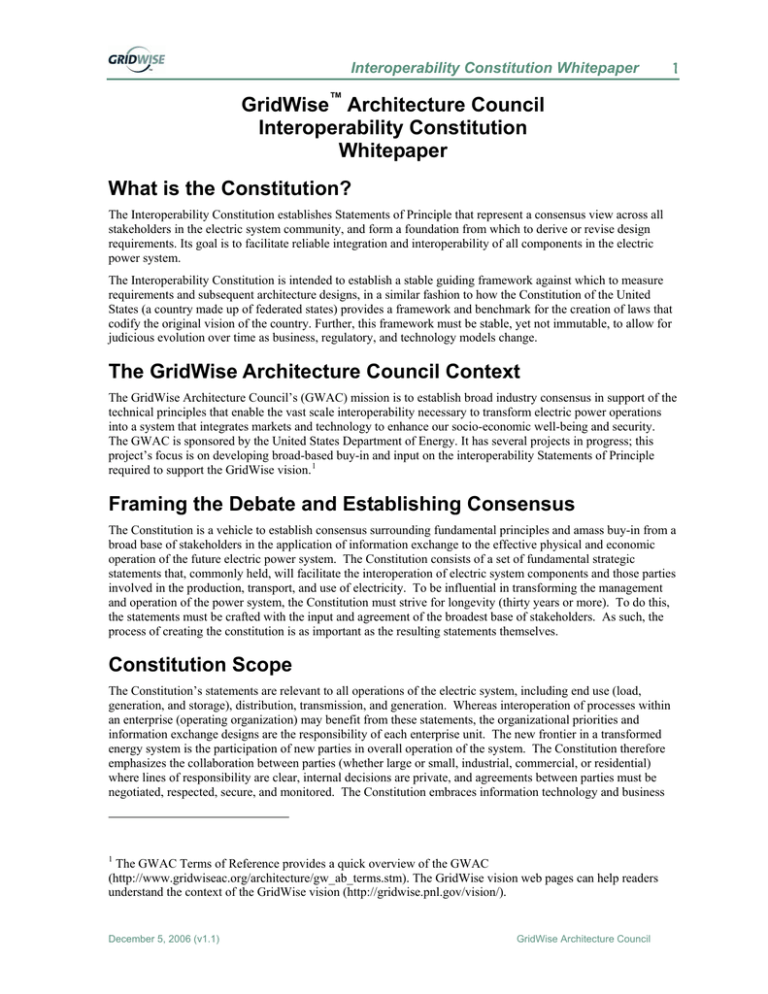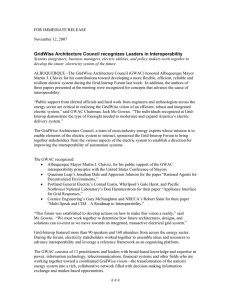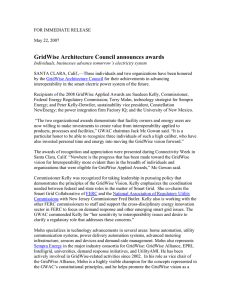GridWise Architecture Council Interoperability Constitution Whitepaper
advertisement

Interoperability Constitution Whitepaper 1 GridWise™ Architecture Council Interoperability Constitution Whitepaper What is the Constitution? The Interoperability Constitution establishes Statements of Principle that represent a consensus view across all stakeholders in the electric system community, and form a foundation from which to derive or revise design requirements. Its goal is to facilitate reliable integration and interoperability of all components in the electric power system. The Interoperability Constitution is intended to establish a stable guiding framework against which to measure requirements and subsequent architecture designs, in a similar fashion to how the Constitution of the United States (a country made up of federated states) provides a framework and benchmark for the creation of laws that codify the original vision of the country. Further, this framework must be stable, yet not immutable, to allow for judicious evolution over time as business, regulatory, and technology models change. The GridWise Architecture Council Context The GridWise Architecture Council’s (GWAC) mission is to establish broad industry consensus in support of the technical principles that enable the vast scale interoperability necessary to transform electric power operations into a system that integrates markets and technology to enhance our socio-economic well-being and security. The GWAC is sponsored by the United States Department of Energy. It has several projects in progress; this project’s focus is on developing broad-based buy-in and input on the interoperability Statements of Principle required to support the GridWise vision. 1 Framing the Debate and Establishing Consensus The Constitution is a vehicle to establish consensus surrounding fundamental principles and amass buy-in from a broad base of stakeholders in the application of information exchange to the effective physical and economic operation of the future electric power system. The Constitution consists of a set of fundamental strategic statements that, commonly held, will facilitate the interoperation of electric system components and those parties involved in the production, transport, and use of electricity. To be influential in transforming the management and operation of the power system, the Constitution must strive for longevity (thirty years or more). To do this, the statements must be crafted with the input and agreement of the broadest base of stakeholders. As such, the process of creating the constitution is as important as the resulting statements themselves. Constitution Scope The Constitution’s statements are relevant to all operations of the electric system, including end use (load, generation, and storage), distribution, transmission, and generation. Whereas interoperation of processes within an enterprise (operating organization) may benefit from these statements, the organizational priorities and information exchange designs are the responsibility of each enterprise unit. The new frontier in a transformed energy system is the participation of new parties in overall operation of the system. The Constitution therefore emphasizes the collaboration between parties (whether large or small, industrial, commercial, or residential) where lines of responsibility are clear, internal decisions are private, and agreements between parties must be negotiated, respected, secure, and monitored. The Constitution embraces information technology and business 1 The GWAC Terms of Reference provides a quick overview of the GWAC (http://www.gridwiseac.org/architecture/gw_ab_terms.stm). The GridWise vision web pages can help readers understand the context of the GridWise vision (http://gridwise.pnl.gov/vision/). December 5, 2006 (v1.1) GridWise Architecture Council Interoperability Constitution Whitepaper 2 connectivity from the concept of a transaction through negotiation, scheduling, operation, settlement, billing, and financial transfers. An example of new party participation in operation of the electric system is the ability of demand (including individual consumers, equipment, and facility systems) to respond to power system market or operationally threatening conditions. Others include the actions and transactions between bulk generation companies, transmission owners, load serving entities, and the markets in which they interact. The evolution of these interactions over time must be reviewed and monitored by those regulatory bodies whose role is to ensure a viable electric system environment that supports our economy and balances issues of social equity each step of the way. To the extent that the Statements of Principle reflect technical strategic directions that empower interactions by interested parties, they are in the scope of this Constitution. Attributes of the Statements of Principle The following attributes apply generally to the concepts behind all Statements of Principle in the Constitution. They are stated here to highlight their importance and remove redundancy in the statements. Simplicity – elegance in succinctness and clarity. Choice – enable and encourage innovation through choice (avoid vendor or incumbent service organization favoritism). Physical realities – acknowledge and respect the laws of physics. Consistency – principles strive to not conflict with one another; however, where contradictions arise, the priority of principle is clearly stated. Interview Process Over 100 stakeholders representing each sector relevant to GridWise took part in the interview process, contributing to increasingly refined and increasingly consensual statements. In the final iteration, about one third of the interviewees voted in agreement or strong agreement to 90% or more of the statements. About 80% of the interviewees were in agreement or strong agreement with 80% or more of the statements: this would indicate very strong consensus in support of these principles. The Constitution is designed to be a living, evolving document; neither perfect, nor finalized. The Constitution Statements presented and signed at the Constitutional Convention are reproduced below. Constitution Statements of Principle B - Business Principles Context: Subject to the regulatory environment in which they operate, organizations are free to structure themselves in the manner they see fit to best deliver goods and services and compete with other businesses. They interact with other organizations through contracts of their own choosing in as open a marketplace as possible. Enterprises can be categorized into wholesale and retail segments; however, the path from producer to consumer may pass through a variety of businesses each providing their unique value added contribution. There is no standard process of running a business. B01- Subject to regulatory monitoring requirements, interoperability approaches should focus on the information exchange and the interaction at the boundary between transacting parties while respecting the privacy of the internal aspects of their business (technology choice and processes). B02- Interoperability approaches must support the ability to roll out changes to contracts or market rules while preserving stable operation of the overall electric system. B03- Interoperability approaches must address the common types of marketplace transactions among parties along the path between producers and consumers appropriate to the level of service provided. December 5, 2006 (v1.1) GridWise Architecture Council Interoperability Constitution Whitepaper B04- Interoperability approaches must consider implementation costs/benefits and impacts to the parties involved in the transaction. B05- Interoperability approaches must support verification and auditability of transaction completion and be able to validate that contract terms have been met. U - Usability Principles Context: Electricity users have a wide range of needs and energy management capabilities, as well as varying degrees of willingness to pay for any given energy product. The new frontier in a transformed energy system is the participation of new parties in overall system operations, including end use, distribution, transmission, and generation. U01- Interoperability approaches should address the technical capabilities needed to support the emergence of markets for consumers to choose the appropriate electricity service program they desire. U02- In the event of a communications failure between interacting parties, the parties must assume operating positions that best preserve stable operation of the overall electric system. U03- Interoperability strategies should be communicated in appropriate ways that can be understood and adopted by all stakeholders in the electric system. I - Information Technology Principles Context: Advances in information technology empower electronic business and intelligent machine connectivity. Large sectors of the economy rely on information technology to enable greater levels of productivity, efficiency, and reliability of service. This provides a vast marketplace for the application of information technology and reduces the need for industry specific information technology approaches. Information technology is characterized by a high rate of innovation with impacts to large scale systems of systems that must cope with the deployment of new solutions as legacy approaches continue to operate in tandem. I01- A broadly held interoperability strategy can help organize and advance the large scale integration of automated equipment, business processes, and human interactions. I02- Strategies for interoperability shall adopt the broadly applicable best practices of information science to improve end to end performance of both business and the electric system’s operation and managerial processes. I03- An interoperability framework shall address a strategy for the identification of system entities beyond organizational boundaries to ensure unambiguous interactions, and shall support the naming of groups or collections of system entities. I04- An interoperability framework shall incorporate information modeling approaches that define the shared meaning and relationships of entities and concepts applicable to interactions in an area of industry or commerce. I05- Interoperability strategies shall address time synchronization, sequence of events, time tagging, and other requirements related to time as appropriate to the service provided. I06- Interoperability strategies shall address the ability to set up (i.e., discover and configure) system components so they can join, modify (e.g., upgrade), and terminate their positions in the system. I07- An interoperability framework must address information system security and privacy concerns, balance them appropriate to the service provided, and support adaptation to future risks. I08- As appropriate to each interaction, an interoperability framework should address strategies for e-business transactions that may include creation of a transaction, negotiation, scheduling, operations, settlement, billing and financial transfers. December 5, 2006 (v1.1) GridWise Architecture Council 3 Interoperability Constitution Whitepaper 4 I09- An interoperability framework must be practical and achievable: • • • • Meets performance requirements. Is reliable. Is scalable. Has sufficient breadth to meet the range of business needs. I10- An interoperability strategy must accommodate the coexistence of and evolvement through several generations of IT standards and technologies that will reside at any point in time on the Grid. R - Regulatory Principles Context: Business is conducted under a formal set of rules or laws meant to follow policy guidelines. The rules are set, maintained, and enforced by various local, state, and federal agencies in accordance with their jurisdictions. Business interactions associated with the electric industry are reviewed and monitored by those regulatory bodies whose role is to ensure a viable electric system environment that supports our economy and balances issues of social equity. R01- Interoperability strategies and issues must be communicated in a form to be understood by regulators and policy makers. R02- Interoperability approaches among organizations must allow regulators the ability to verify that business is conducted within established rules and that all relevant transactions are auditable. G - Governance Principles Context: This constitution is a living, evolving document that influences the long-term future of the electric power system. Though the Statements of Principle are meant to be long lived, the ability to correct, update, and clarify this constitution is recognized. G01- An interoperability framework must consider the needs and views of the full range of stakeholders in an integrated view of the electric system. G02- Governance processes should measure successes and shortcomings of the interoperability framework, and drive improvement. G03- The governance of this constitution must be independent of any particular standards organization and preserve the technical neutrality of these principles. G04- With regard to encouraging standards and standards development, the governance of this constitution: • Will encourage development of standards where appropriate to constitution objectives and work with existing groups to guide standards development toward better achieving interoperability; • Will endorse and/or recommend standards where appropriate to constitution objectives; and • Will proactively encourage collaboration, merging, and rationalization of standards where appropriate to constitution objectives. • Does not develop detailed specifications for standards. G05- These long lived Statements of Principle and the strategic approaches that derive from them must be able to change through time in a prudent, controlled manner. December 5, 2006 (v1.1) GridWise Architecture Council







